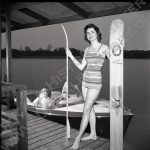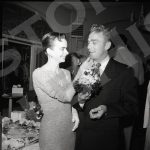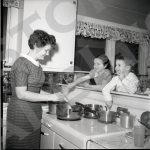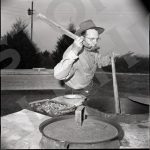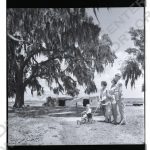Photographs of Everyday Life
Photographs of Everyday Life
{Pictured Above: One of the treasures of the Guy Hayes collection. Pictured is a kitsch image of a puppy in a cream pitcher. Though taken earlier, this photo echoes the popular pet images of today (Image courtesy of the DeKalb History Center)}
At first glance, the Guy Hayes Collection may look simple but take a second look. The photographs are a delightful look into everyday life in Georgia from the 1950’s to the mid-1960’s. The subjects are ranging: sporting events, gubernatorial races, the civil rights movement, etc. Hayes photographs reveal a changing America, a culture in constant flux.
After World War II, America became an economic and political behemoth, countered only by the Soviet Union. The economy was strong due to a continuation of the wartime industrial build-up. Young men, returning after the war, settled down, and created families; this resulted in the Baby Boomer generation. The landscape changed with suburbs expanding, rapidly becoming the preferred living areas for the rising middle class. The end of the war and new affluence meant that American families had increased leisure time. This created a new consumer culture around the television. More than ever before, Americans were fascinated celebrities. Outdoor recreation and parties, particularly food, became a way to advertise their newly affluent status.

This photo is a self-portrait of photographer Guy Hayes taken in 1984 (DeKalb History Center)
Hayes himself was indicative of post-war trends. Hayes had served in the Navy during World War II and returned after to live in Avondale Estates. Prior to his deployment, he had worked as a photographer for local newspapers. He quickly resumed this work for the next fifty years, freelancing for the Atlanta Journal and the DeKalb News/Sun. He remained a DeKalb County resident until his death in 1998.
The Hayes collection is vast: the DeKalb History Center has over 12,000+ negatives covering a period of over forty years. This is a rich resource for academics and the general public. The Hayes Collection is enjoying a second life on social media, where it has proven popular. This is understandable: they are not only historically interesting but visually so. Take the picture of the dog in the teacup or the cat pushing the baby stroller. These were kitsch images, but, like our forefathers, who doesn’t love pictures of adorable pets acting in ‘unorthodox ways?
The Hayes Collection shows extraordinary breadth. It illustrates the changing fashions from boxy, military-inspired suits to full, calf-length skirts. Women are often seen in domestic roles, cooking or taking care of the household. The nuclear family is a stable and consistent presence. It is likely that Hayes thought little of his work. He photographed ordinary life, nothing more or nothing less. Yet, the Hayes collections provide us, well separated from the past, with a glimpse of how our forefathers lived.
- Glamorous transportation options; we don’t travel like this anymore!
- Delta passenger disembarking in the 1950’s.
- A Davison’s department store model poses with the latest fashions in 1958.
- Pictured is a couple feeding each other in November 1957.
- Hayes was on a food assignment for the AJC and took this photo in November 1957.
- A man tastes his good home-style southern cooking in December 1959
- In the 1970’s, protesters sit in on sanitation protest.
- Decatur pictured in 1981.
- Family vacation to the deep south.
The DeKalb History Center’s Behind the Scenes series allow the general public to explore the museum’s collections & archives. For more content like this, please visit our post on the Infantry Flag.
Written by Samantha Mooney




